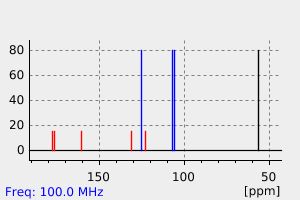5-methoxyindole-4,7-quinone
中文名称
——
中文别名
——
英文名称
5-methoxyindole-4,7-quinone
英文别名
5-methoxy-1H-indole-4,7-dione
CAS
——
化学式
C9H7NO3
mdl
——
分子量
177.159
InChiKey
VVHSETXVMNVIMK-UHFFFAOYSA-N
BEILSTEIN
——
EINECS
——
-
物化性质
-
计算性质
-
ADMET
-
安全信息
-
SDS
-
制备方法与用途
-
上下游信息
-
文献信息
-
表征谱图
-
同类化合物
-
相关功能分类
-
相关结构分类
计算性质
-
辛醇/水分配系数(LogP):0.8
-
重原子数:13
-
可旋转键数:1
-
环数:2.0
-
sp3杂化的碳原子比例:0.11
-
拓扑面积:59.2
-
氢给体数:1
-
氢受体数:3
反应信息
-
作为产物:描述:参考文献:名称:Antimicrobial indolequinones from the mid-intestinal gland of the muricid gastropod Drupella fragum摘要:Three new indolequinones, 6-merhoxyindole-4,7-quinone (1), 5-methoxyindole-4,7-quinone (2) and 5-methylindole-4,7-quinone (3) were isolated from the mid-intestinal gland of the muricid gastropod Drupella fragum. The structures of 1 and 2 were established by spectroscopic methods and total synthesis, whereas the structure of 3 was elucidated mainly by NMR spectroscopic analyses. Compounds 1 3 exhibited moderate antimicrobial activities against Staphylococcus aureus, Bacillus subtilis, and Escherichia coli with MIC = 6.25 similar to 50 mu g/mL. (C) 1998 Elsevier Science Ltd. All rights reserved.DOI:10.1016/s0040-4020(98)00593-6
文献信息
-
Iridium-Catalyzed C–H Borylation-Based Synthesis of Natural Indolequinones作者:Christy Wang、Jonathan SperryDOI:10.1021/jo300330u日期:2012.3.16An iridium-catalyzed C-H borylation provides the key step in a short synthesis of two indolequinone natural products. This regioselective C-H functionalization strategy delivers 7-borylindoles that undergo facile oxidation hydrolysis to 7-hydroyindoles and subsequent oxidation to the desired indolequinones, thereby demonstrating a powerful application of the iridium-catalyzed C H borylation reaction. A significant result has arisen from the iridium-catalyzed borylation of N-diethylhydrosilyl-6-methoxyindole; even in the presence of a substituent at C6, the N-hydrosilyl group still directs borylation exclusively into the more sterically hindered C7 position in preference to C2.
表征谱图
-
氢谱1HNMR
-
质谱MS
-
碳谱13CNMR
-
红外IR
-
拉曼Raman
-
峰位数据
-
峰位匹配
-
表征信息
同类化合物
(Z)-3-[[[2,4-二甲基-3-(乙氧羰基)吡咯-5-基]亚甲基]吲哚-2--2-
(S)-(-)-5'-苄氧基苯基卡维地洛
(R)-(+)-5'-苄氧基卡维地洛
(R)-卡洛芬
(N-(Boc)-2-吲哚基)二甲基硅烷醇钠
(E)-2-氰基-3-(5-(2-辛基-7-(4-(对甲苯基)-1,2,3,3a,4,8b-六氢环戊[b]吲哚-7-基)-2H-苯并[d][1,2,3]三唑-4-基)噻吩-2-基)丙烯酸
(4aS,9bR)-6-溴-2,3,4,4a,5,9b-六氢-1H-吡啶并[4,3-B]吲哚
(3Z)-3-(1H-咪唑-5-基亚甲基)-5-甲氧基-1H-吲哚-2-酮
(3Z)-3-[[[4-(二甲基氨基)苯基]亚甲基]-1H-吲哚-2-酮
(3R)-(-)-3-(1-甲基吲哚-3-基)丁酸甲酯
(3-氯-4,5-二氢-1,2-恶唑-5-基)(1,3-二氧代-1,3-二氢-2H-异吲哚-2-基)乙酸
齐多美辛
鸭脚树叶碱
鸭脚木碱,鸡骨常山碱
鲜麦得新糖
高氯酸1,1’-二(十六烷基)-3,3,3’,3’-四甲基吲哚碳菁
马鲁司特
马鞭草(VERBENAOFFICINALIS)提取物
马来酸阿洛司琼
马来酸替加色罗
顺式-ent-他达拉非
顺式-1,3,4,4a,5,9b-六氢-2H-吡啶并[4,3-b]吲哚-2-甲酸乙酯
顺式-(+-)-3,4-二氢-8-氯-4'-甲基-4-(甲基氨基)-螺(苯并(cd)吲哚-5(1H),2'(5'H)-呋喃)-5'-酮
靛青二磺酸二钾盐
靛藍四磺酸
靛红联二甲酚
靛红磺酸钠
靛红磺酸
靛红乙烯硫代缩酮
靛红-7-甲酸甲酯
靛红-5-磺酸钠
靛红-5-磺酸
靛红-5-硫酸钠盐二水
靛红-5-甲酸甲酯
靛红
靛玉红衍生物E804
靛玉红3'-单肟5-磺酸
靛玉红-3'-单肟
靛玉红
靛噻
青色素3联己酸染料,钾盐
雷马曲班
雷莫司琼杂质13
雷莫司琼杂质12
雷莫司琼杂质
雷替尼卜定
雄甾-1,4-二烯-3,17-二酮
阿霉素的代谢产物盐酸盐
阿贝卡尔
阿西美辛杂质3







